You'll achieve beautiful botanical scents in your soap by following 10 proven methods: infuse dried herbs in carrier oils at a 1:4 ratio, maintain a 3% essential oil usage rate, combine complementary botanicals like lavender and rosemary, use cold infusion for delicate scents, heat-infuse stronger herbs, strain thoroughly through cheesecloth, document your recipes, conduct patch tests, store in cool dark places, and balance scent concentrations carefully. Master these techniques to reveal nature's full aromatic potential in your soap making journey.
Essential Oil Infusion Basics for Natural Soaps

When creating naturally scented soaps, essential oil infusions offer a pure and authentic way to capture botanical fragrances.
To begin your essential oil infusion, select fresh plant material and combine it with your chosen carrier oils in a clean container. You'll want to let this mixture steep for several weeks in a warm, dark place, occasionally shaking it to help extract the aromatic compounds.
Once your infused oil is ready, strain it through cheesecloth to remove any plant particles that could affect your soap's appearance.
Remember to stick to a 3% usage rate of essential oils by weight of your total oils to maintain a safe and balanced scent profile.
Before using any new blend in your soap, don't forget to conduct patch tests to check for potential skin sensitivities.
Dried Herb and Flower Oil Infusions
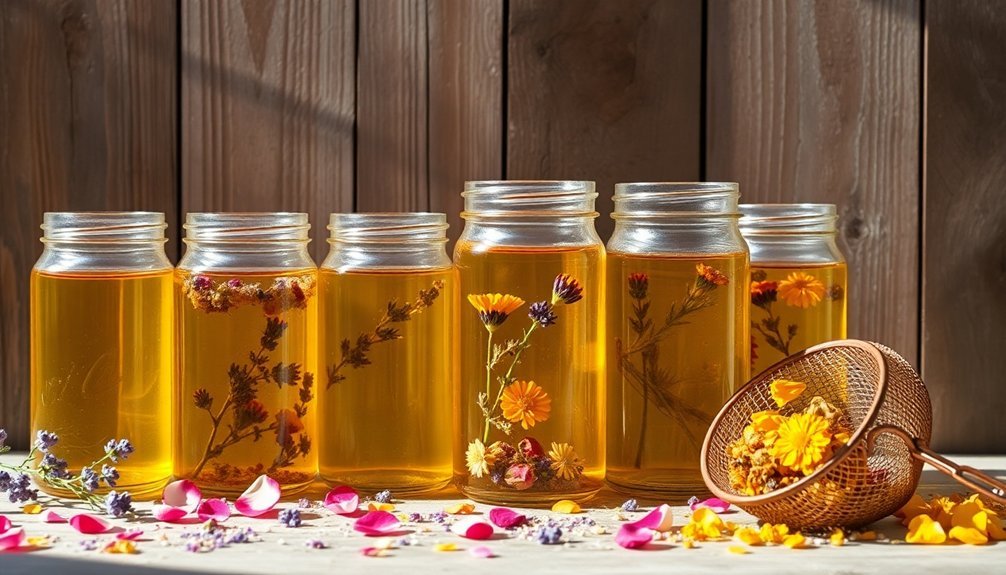
When selecting herbs and flowers for soap infusions, choose aromatic options like lavender, chamomile, rosemary, calendula, or rose petals that'll complement your intended soap design.
You'll need to allow 1-4 weeks for your botanicals to properly infuse into the carrier oil at a 1:4 ratio, making sure they're completely covered to prevent spoilage.
Once your infusion is complete, strain the mixture through cheesecloth or a fine mesh sieve before adding it to your soap at 1-2 tablespoons per pound of base oils.
Selecting Ideal Infusion Herbs
To create beautifully scented soaps, selecting the right dried herbs and flowers for oil infusion makes all the difference.
You'll want to start with classic aromatics like lavender, chamomile, and rosemary, which readily release their natural fragrance into carrier oils. Calendula and hibiscus not only contribute pleasant scents but also add stunning natural color to your infused oil.
For the best results, you'll need to use the correct proportions – mix 1 part dried herbs to 2-3 parts oil.
Consider gently heating your mixture to no more than 120°F to enhance the infusion process, though you can also opt for a longer cold infusion of 2-6 weeks.
Once your herbs have released their fragrance, strain the infused oil through cheesecloth before incorporating it into your soap recipes.
Oil Infusion Time Guidelines
Although infusing oils with dried herbs and flowers requires patience, following the proper timing guidelines guarantees ideal fragrance extraction.
You'll need to allow 4 to 6 weeks for the infusion process when working with dried herbs and your chosen carrier oil. Use a ratio of 1 ounce of dried herbs per cup of oil to achieve the best concentration.
If you're short on time, you can speed up the process by creating a warm infusion, heating your mixture gently for 2 to 8 hours.
Once your infusion time is complete, strain the mixture through cheesecloth or fine mesh to remove any plant particles.
For preserving scent and extending shelf life, store your infused oil in a cool, dark place. This protects the aromatic compounds from degrading due to light and heat exposure.
Strain and Store Properly
Proper straining and storage techniques make the difference between a successful botanical infusion and one that spoils prematurely.
Once your dried botanicals have steeped for 4-6 weeks, you'll need to strain the infused oils through a fine mesh strainer or cheesecloth. This essential step removes all solid particles, giving you a smooth, clear liquid that's perfect for soap making.
Transfer your strained oils to dark glass bottles, which protect them from light exposure that could degrade their quality.
Don't forget to label each bottle with the infusion date and botanical type – you'll want this information to track freshness and potency.
Store your infused oils in a cool, dry place to maximize their shelf life. For the best results in your soap making projects, plan to use these oils within 6-12 months before their beneficial properties begin to fade.
Cold Vs Hot Botanical Infusion Methods
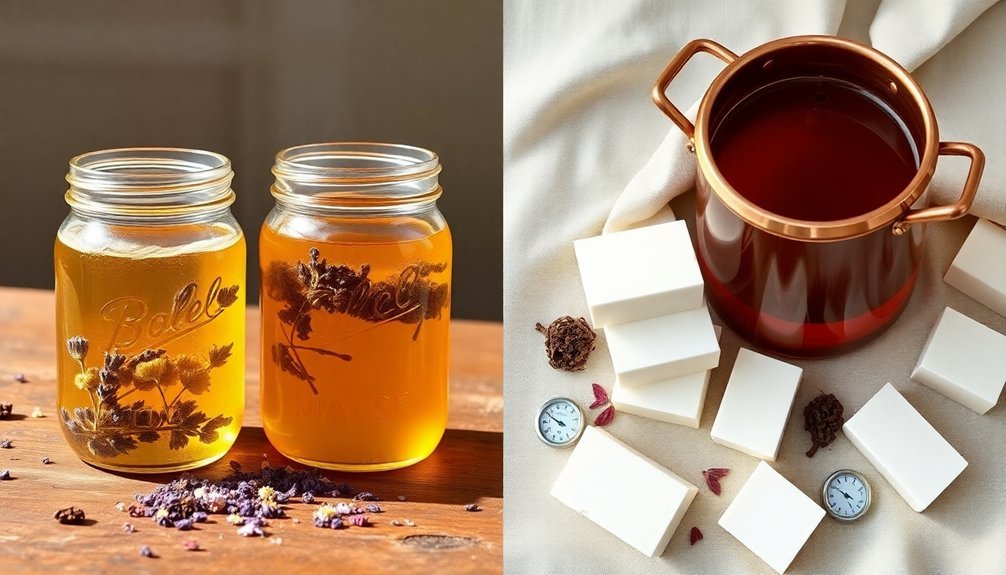
You'll need to choose between cold infusion, which requires several weeks but preserves delicate scents, and hot infusion, which works faster but needs careful temperature monitoring to prevent oil degradation.
When using hot infusion, never leave your oils unattended and maintain temperatures below 140°F (60°C) to protect both the botanical properties and your safety.
For cold infusion, plan to let your botanicals steep for 4-6 weeks in a cool, dark place, shaking the mixture occasionally to guarantee even distribution of the plant's properties throughout the oil.
Hot Infusion Safety Guidelines
When working with botanical infusions in soap making, understanding the key differences between hot and cold methods can greatly impact your final product's quality and safety. While hot infusion excels at extracting aromatic compounds quickly, you'll need to monitor temperature carefully to protect delicate compounds from damage.
| Safety Aspect | Guidelines |
|---|---|
| Temperature Control | Keep heat steady, avoid overheating |
| Straining Process | Strain thoroughly to remove all particles |
| Quality Testing | Conduct test batches before full production |
Always strain your hot infusions meticulously to prevent any solid particles from affecting your soap's texture. This step also helps prevent mold growth by ensuring no moisture remains in your final product. Remember to start with small test batches to evaluate how well your chosen botanicals retain their scent and properties throughout the soap-making process.
Cold Infusion Time Requirements
Having covered hot infusion safety, let's explore how time influences cold infusion methods.
When you're working with cold infusion methods, you'll need to allow 2 to 6 weeks for proper extraction of fragrance from your botanicals. While this might seem lengthy compared to hot infusion's 1-2 hours, the wait is worth it for preserving delicate aromatic qualities.
You'll find cold infusion particularly effective for volatile botanicals like flowers and light herbs. The gentle, room-temperature process protects their natural scents from heat degradation.
Remember to strain your infused oil thoroughly once the steeping period is complete. Though the process requires patience, you're rewarded with superior fragrance preservation. The extended timeline allows for complete extraction while maintaining the integrity of your chosen botanicals.
Choosing Between Infusion Methods
Since both cold and hot infusion methods offer distinct advantages, selecting the right approach depends largely on your specific botanical choices and desired outcomes.
When you're aiming for subtle, true-to-nature scents, cold infusion is your best bet. You'll need to steep your botanicals in carrier oil for several weeks at room temperature, but you'll preserve their delicate properties.
If you're seeking stronger aromas and faster results, hot infusion might be your preferred method. While heating your carrier oil with botanicals accelerates scent extraction, be aware that it can alter some of the botanicals' natural qualities.
Whichever infusion method you choose, remember to use only high-quality dried materials to prevent mold growth, and always strain your infused oil thoroughly before adding it to your soap mixture.
Balancing Natural Scent Concentrations
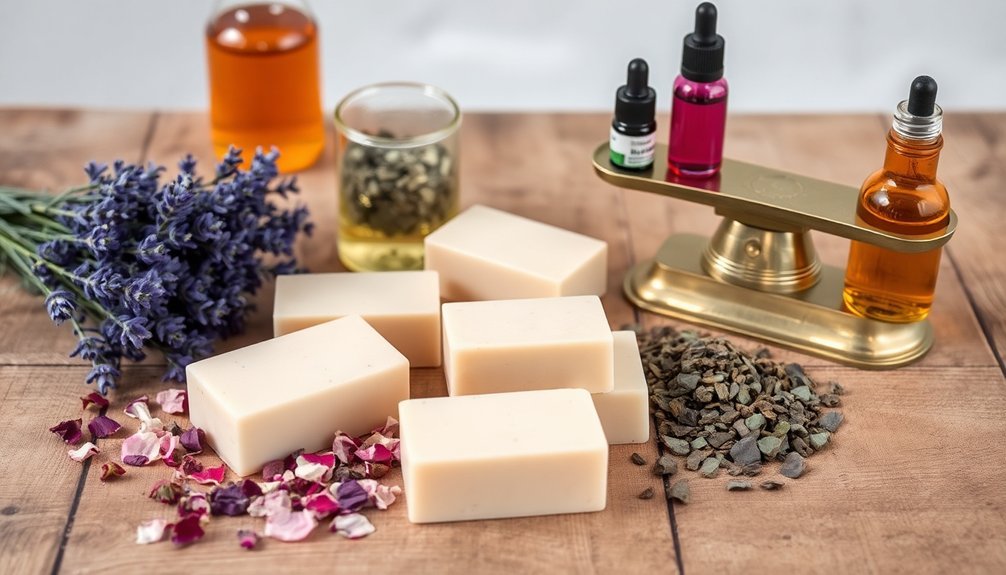
The delicate art of balancing natural scent concentrations in soap making requires precise measurements and careful contemplation of botanical potency.
Creating perfectly scented soap demands exacting precision and a deep understanding of how natural botanical ingredients express their aromatic qualities.
You'll want to start with essential oils or infused oils at a 3% usage rate by weight of your total recipe. When working with dried plant material, remember to add small amounts – about 1/2 to 1 teaspoon per pound of soap.
Before committing to a large batch, always create a small test batch to evaluate your botanical blend's performance.
Here's what you'll need to take into account:
- Natural ingredients like ground spices and dried herbs require larger quantities for noticeable scent
- Infusions from chai spices or citrus peels add subtle aromas that work best when combined with essential oils
- Test different concentrations with small batches to determine ideal scent retention during saponification
Creating Custom Botanical Blends
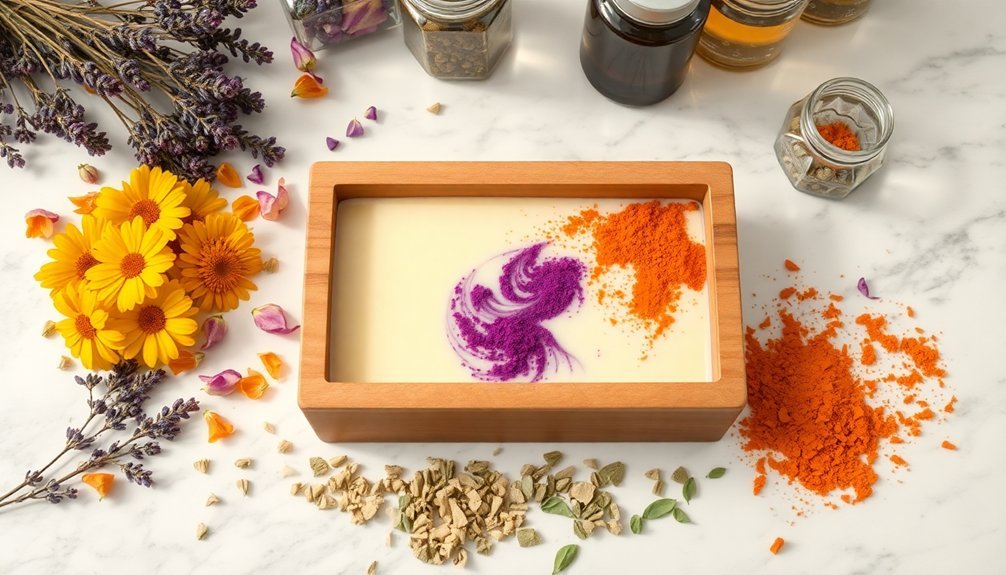
You'll want to begin your custom botanical blend by carefully selecting complementary dried herbs, flowers, and spices that work together, such as pairing floral lavender with woody rosemary.
To intensify natural scents, try infusing your chosen botanicals in carrier oils for several weeks before incorporating them into your soap recipe.
When combining multiple botanical elements, start with equal ratios and adjust the intensity levels based on how the scents interact with each other, keeping detailed notes of your formulations.
Selecting Complementary Plant Materials
Creating harmonious botanical blends requires understanding the interplay between different scent notes and their lasting power in soap. When selecting plant materials, focus on oil-soluble botanicals that'll contribute effectively to scent retention.
You'll want to combine various fragrance profiles using essential oils and infusing oils with dried herbs for depth.
Consider these complementary combinations for ideal results:
- Pair citrus-based top notes with floral middle notes for brightness
- Choose woody base notes like cedarwood to anchor your botanical blends
- Mix dried herbs with carrier oils to extract maximum aromatic compounds
Test small batches of your combinations before scaling up production.
Keep detailed notes on which botanical blends work best, paying attention to how different plant materials interact and maintain their scent over time. This documentation will help you refine future formulations.
Natural Infusion Methods Today
While traditional soap making relied on simple herb additions, modern natural infusion methods offer sophisticated ways to develop complex botanical blends.
You'll want to start by combining your chosen botanicals with carrier oils at a 1:3 ratio for maximum scent extraction. Whether you're using dried herbs, flowers, or aromatic spices, the cold infusion process preserves their delicate properties and creates nuanced fragrances.
For the best results in Cold Process soap making, let your infused oils steep at room temperature for several weeks.
You can experiment with complementary combinations, like pairing rosemary with lavender, to create unique scent profiles.
Before committing to a large batch, always test small amounts of your infused oils to evaluate how the fragrance performs during saponification. This careful approach guarantees your botanical blends deliver the desired aroma in your finished soap.
Balancing Scent Intensity Levels
Mastering the art of botanical blends requires careful attention to scent intensity levels. When crafting your custom soap, you'll want to use essential oils at 3% of your total recipe weight to achieve the perfect fragrance balance.
While dried herbs and flowers can add subtle aromas, they're best combined with stronger scent sources for noticeable results.
To create well-balanced botanical blends, consider these key elements:
- Layer your scents with top notes (citrus), middle notes, and base notes (cedarwood) for depth
- Infuse carrier oils with botanicals before soap making, but remember to strain thoroughly
- Test your blends in small batches to perfect the intensity
Starting with small test batches lets you fine-tune your scent combinations before committing to larger productions, ensuring your final product delivers the exact fragrance profile you're aiming for.
Preserving Botanical Fragrances During Curing
Successfully preserving botanical fragrances throughout the soap curing process requires careful attention to both ingredients and technique.
You'll need to combine essential oils or fragrance oils with your botanicals to guarantee lasting scents, as dried plants alone won't provide sufficient fragrance intensity.
To maximize scent retention, start by infusing oils with your chosen botanicals before adding them to your soap mixture.
Make certain these oils are compatible with the saponification process. You'll want to finely grind your botanicals or properly infuse them to prevent moisture absorption that can lead to browning and scent deterioration.
Don't add fresh botanicals with high water content directly to your soap batter, as excess moisture will weaken the fragrance.
Store your curing soaps in a cool, dark, and dry space to maintain the botanical scents' potency.
Plant-Based Scent Fixatives and Anchors
To enhance the staying power of botanical scents in your soap, natural fixatives and anchors play an essential role in the formulation process.
Plant-based scent fixatives like orris root powder and benzoin resin help bind essential oils, ensuring your soap maintains its delightful aroma throughout its use.
Key natural anchors you'll want to take into account:
- Kaolin clay absorbs and locks in fragrances, creating a more stable scent profile
- Honey and milk naturally anchor essential oils while adding moisturizing benefits
- Pre-infused aromatic botanicals strengthen fragrance retention during curing
For best results, combine these fixatives with essential oils at up to 3% of your recipe's weight.
This combination creates a robust, long-lasting scent that won't fade quickly.
When you're crafting your next batch, remember that these natural anchors work together to enhance your soap's overall fragrance performance.
Seasonal Botanical Selection Guide
Selecting the right botanicals for each season can dramatically enhance your soap's sensory appeal and market value.
For spring and summer, you'll want to incorporate seasonal botanicals like lavender and chamomile, which provide light, rejuvenating scents perfect for warmer months.
When autumn arrives, switch to warming spices like cinnamon and clove to create soaps that capture the cozy essence of fall.
Winter calls for evergreen botanicals such as pine needles and cedarwood, delivering crisp, stimulating aromas that your customers will associate with holiday festivities.
Don't forget to maximize the potential of citrus botanicals during summer – they'll add zesty, uplifting notes to your creations.
To guarantee the best results, always time your botanical selections with their peak harvest seasons, ensuring peak fragrance and potency in your finished soaps.
Common Botanical Infusion Mistakes to Avoid
While botanical infusions can elevate your soap's natural fragrance, several common mistakes can derail your efforts. You'll want to avoid using dried botanicals with low scent potency, as they'll result in barely noticeable aromas.
When preparing infused oils, careful temperature control is essential – overheating will destroy the fragrant compounds you're trying to capture.
- Don't skip straining your infused oils properly, or you'll end up with unwanted particles that compromise your soap's texture.
- Watch your usage rates carefully – excess botanical material leads to discoloration and texture issues.
- Always run test batches before scaling up, since botanicals can react differently during the saponification process.
Testing and Documenting Scent Success
Since successful botanical scenting requires careful experimentation, you'll need a systematic approach to testing and documentation.
Start by running small test batches, using just 1/2 to 1 teaspoon of botanicals per pound of soap to evaluate their scent potential and staying power.
Create a detailed testing log where you'll record every aspect of your infusion process, including the type and amount of botanicals used, infusion duration, and scent observations throughout the curing period.
When evaluating your finished soap, use the wafting technique to assess the aroma's strength and character. Document which botanicals maintain their fragrance and which fade quickly.
These thorough notes will become your valuable reference guide, helping you refine your botanical scenting techniques and avoid repeating unsuccessful combinations.
Frequently Asked Questions
How to Add Natural Scent to Soap?
You'll get natural soap scents by infusing oils with dried herbs, adding essential oils at 3% by weight, and mixing in dried botanicals like rosemary or lavender. Don't use sweet or acidic ingredients.
How Do You Add Botanicals to Soap?
You can add botanicals to soap by infusing dried herbs into oils, mixing pureed fresh herbs into soap batter, or sprinkling dried flowers on top. Use 1/2 to 1 teaspoon per pound of soap.
How Do You Make the Best Smelling Soap?
You'll create the best smelling soap by adding essential oils at 3% by weight, blending top, middle, and base notes. Infuse your oils with botanicals, but avoid sugary additives that can disrupt fragrance retention.
What Ingredient Makes Soap Smell Good?
Essential oils are your best bet for making soap smell good. You'll want to add them at 3% of your total recipe weight. They'll provide the strongest, longest-lasting fragrance in your finished soap.
In Summary
You've now got the essential knowledge to create beautifully scented soaps using natural botanicals. Start with simple single-herb infusions, then experiment with custom blends as your confidence grows. Remember to document your successes and failures, test your concentrations carefully, and always use proper fixatives. With practice, you'll develop your own signature botanical soap scents that'll rival any commercial products.

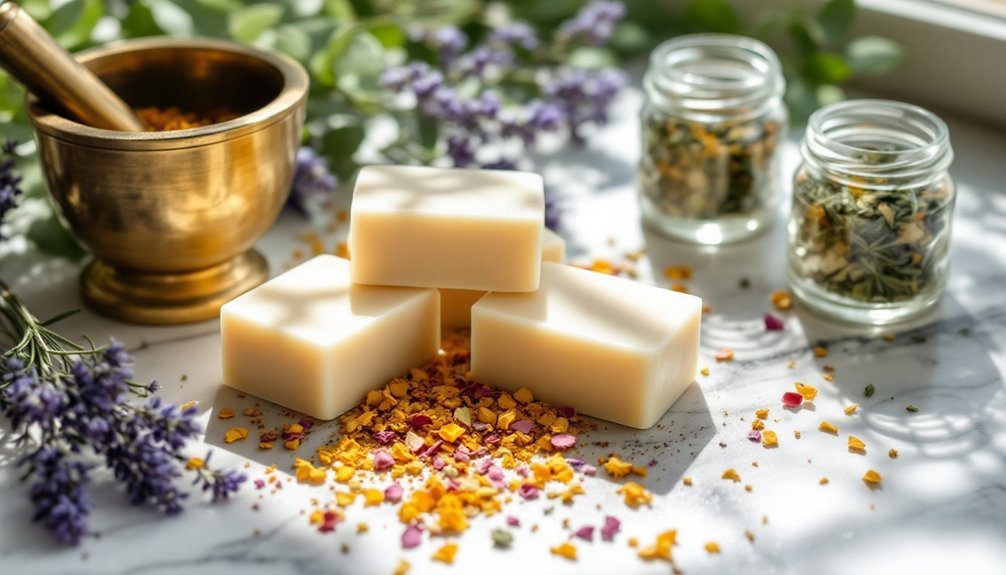
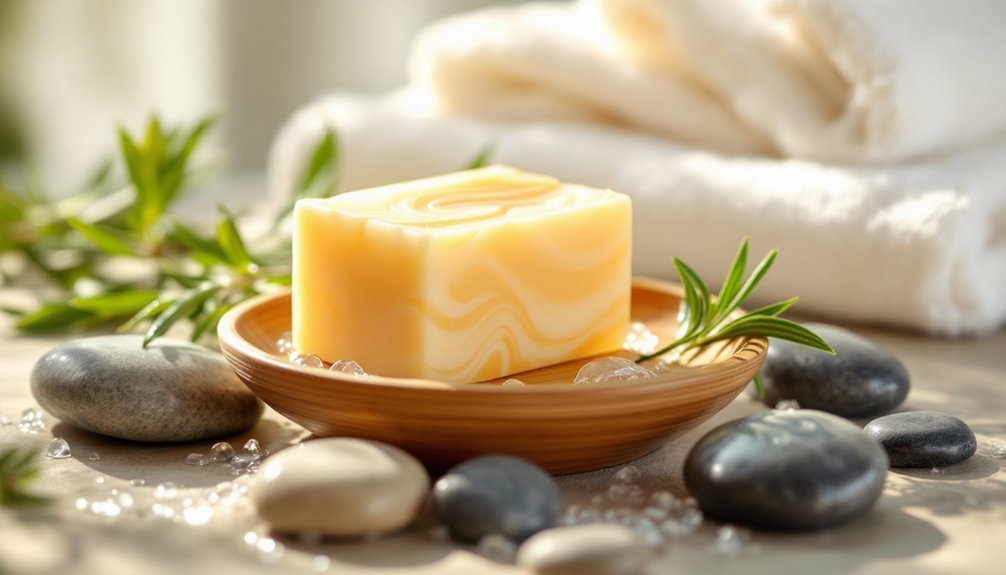
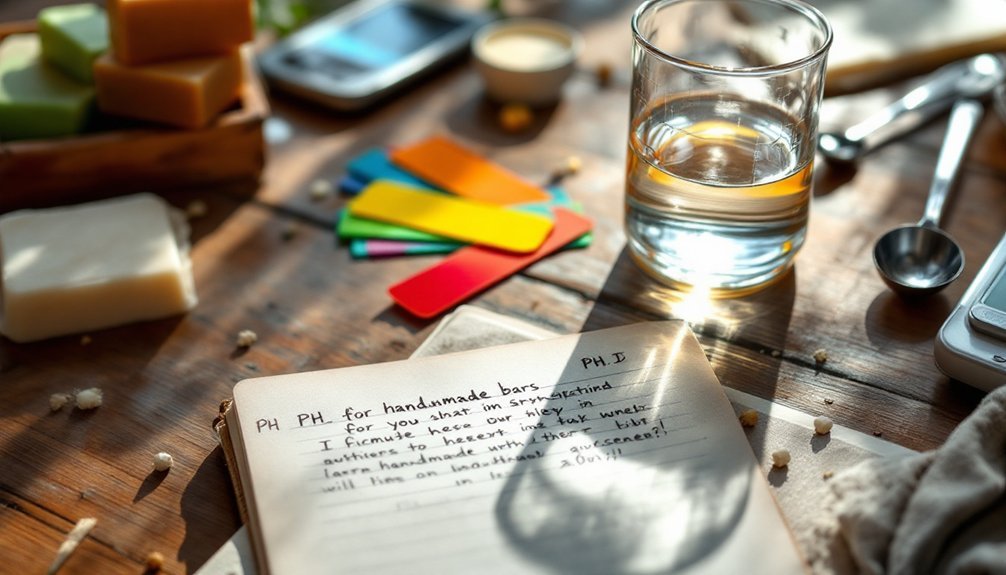
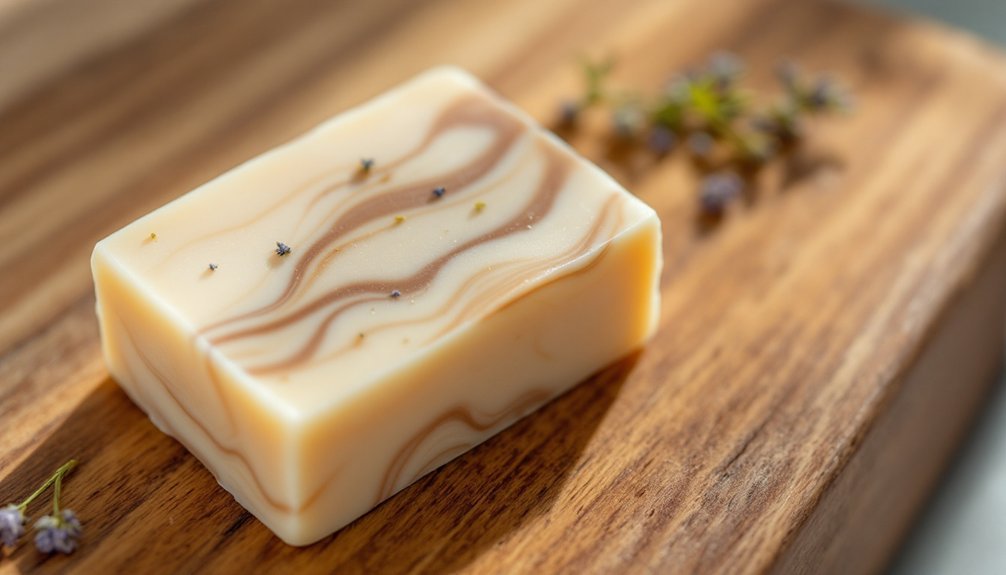
Leave a Reply